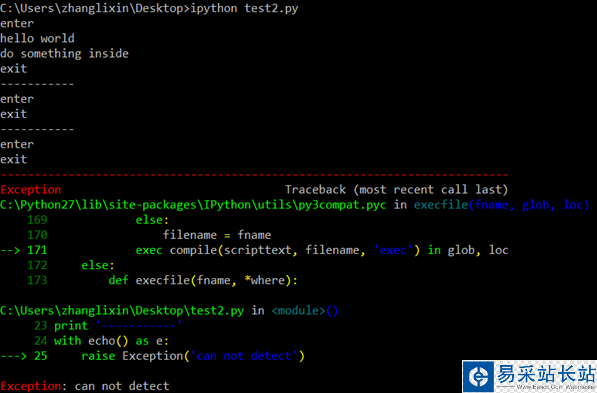本文實例講述了Python中with及contextlib的用法。分享給大家供大家參考,具體如下:
平常Coding過程中,經常使用到的with場景是(打開文件進行文件處理,然后隱式地執行了文件句柄的關閉,同樣適合socket之類的,這些類都提供了對with的支持):
with file('test.py','r') as f : print f.readline()with的作用,類似try...finally...,提供一種上下文機制,要應用with語句的類,其內部必須提供兩個內置函數__enter__以及__exit__。前者在主體代碼執行前執行,后則在主體代碼執行后執行。as后面的變量,是在__enter__函數中返回的。通過下面這個代碼片段以及注釋說明,可以清晰明白__enter__與__exit__的用法:
#!encoding:utf-8class echo : def output(self) : print 'hello world' def __enter__(self): print 'enter' return self #返回自身實例,當然也可以返回任何希望返回的東西 def __exit__(self, exception_type, exception_value, exception_traceback): #若發生異常,會在這里捕捉到,可以進行異常處理 print 'exit' #如果改__exit__可以處理改異常則通過返回True告知該異常不必傳播,否則返回False if exception_type == ValueError : return True else: return Falsewith echo() as e: e.output() print 'do something inside'print '-----------'with echo() as e: raise ValueError('value error')print '-----------'with echo() as e: raise Exception('can not detect')運行結果:

contextlib是為了加強with語句,提供上下文機制的模塊,它是通過Generator實現的。通過定義類以及寫__enter__和__exit__來進行上下文管理雖然不難,但是很繁瑣。contextlib中的contextmanager作為裝飾器來提供一種針對函數級別的上下文管理機制。常用框架如下:
from contextlib import contextmanager@contextmanagerdef make_context() : print 'enter' try : yield {} except RuntimeError, err : print 'error' , err finally : print 'exit'with make_context() as value : print valuecontextlib還有連個重要的東西,一個是nested,一個是closing,前者用于創建嵌套的上下文,后則用于幫你執行定義好的close函數。但是nested已經過時了,因為with已經可以通過多個上下文的直接嵌套了。下面是一個例子:
from contextlib import contextmanagerfrom contextlib import nestedfrom contextlib import closing@contextmanagerdef make_context(name) : print 'enter', name yield name print 'exit', namewith nested(make_context('A'), make_context('B')) as (a, b) : print a print bwith make_context('A') as a, make_context('B') as b : print a print bclass Door(object) : def open(self) : print 'Door is opened' def close(self) : print 'Door is closed'with closing(Door()) as door : door.open()
新聞熱點
疑難解答